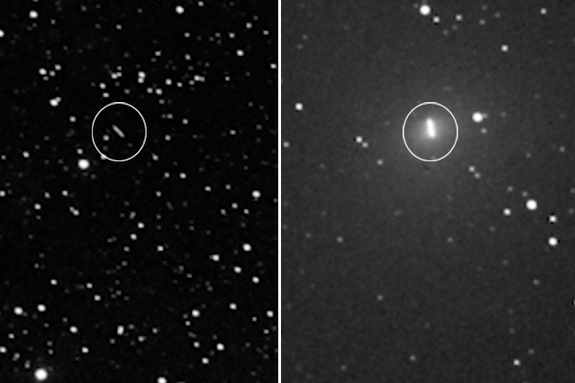"Twin" Comets Make Historic Back-To-Back Near-Earth Flybys
언어
읽기 수준
기사 듣기

This past week was an exciting one for astronomy fans. That's because two comets — 252P and P/2016 BA14 — were scheduled to make their closest approach to Earth, back-to-back. The icy celestial bodies did not disappoint.
이 기사의 나머지 부분을 읽고 학습 도구에 액세스하려면 등록해야합니다.
지금 학습 시작하기댓글 273개
- Iban9년 이상1.They were excited to see 2 comets 2. linear was the first and was 3.5 million miles away and visible from south hemisphere 3.PanSTARRS was the second most closest to earth by 2.2 miles away and it looked like linear.
- Alfonso9년 이상1.)It was exiting because two comets,252P and P/2016 BA14 were going to be close to Earth. 2.)The comet 252P was the first to pass by,it was 3.5 million miles away and it was almost visible in the Southern Hemisphere. 3.)The second comet came on March 22 at 7:30 a.m. PDT and it was closer that the first at only 2.2 million miles away,the comet looked like a brick on one side and like a pear on the other side. Critical Thinking Challenge: The astronauts track the because the want to know where and when they will be able to see them again or if they will ever hit Earth later on in the future.
- Dante Gonzalez9년 이상1. Two comets were scheduled to make their closest approach to earth back to back. 2.252 aka LINEAR was the first to zip past Earth on Monday, March 21. 3,P/2016 BA14 aka PanSTARRS was the comet and made its closest near-Earth flyby the following day (March 22) at 7:30 a.m. PDT (10:30 a.m. EDT), 4.So that they can be able to see what's specifically coming...
- jose,christian9년 이상1. they were supposed to see 2 comets approach earth. 2.the comet linear.it was visible from the southern hemisphere. it came within 3.5 million miles 3.pan STTARS was closer to earth within 2.2 million miles.
- Alejandro 9년 이상1.The to comets were post to come to Earth.2.Linear was the first to get close to earth on march 21 it came 3.5 million miles away from earth it was visable by the naked eye in the southern hemisphere. 3. PanSTARRS the 2nd comet came march 22 it was half the size of Linear it came 2.2 million miles away from earth.
- hector gonzalez9년 이상1.two comets 2.252 aka LINEAR was the first one on Monday, March 21.n the Southern Hemisphere 3.P/2016 BA14 was closest on January 22.it was spotted by University of Hawaii telescope in Maui. 4.so that they can look close to see is something is approaching
- jennifer9년 이상1)Scientists were exited because two comets were supposed to flyby very close to earth. 2)linear was the first,march 21,at 3.5 million miles,it was visible from the southern hemisphere. 3)the second comet came by on march 22,came by 2.2 million miles,it looked like it had a tail which is a characteristic of a comet
- Jason Garay9년 이상1.) That's because two comets — 252P and P/2016 BA14 — were scheduled to make their closest approach to Earth, back-to-back. 2.)252 aka LINEAR was the first to zip past Earth on Monday, March 21. At its closest, the comet which is the bigger of the two came within 3.5 million miles (5.6 kilometers) or about 14 times the distance from the Earth to the Moon. This made it the fifth closest comet encounter in recorded history. According to AccuWeather Meteorologist, Dave Samuhel, LINEAR was almost visible to the unaided eye in the Southern Hemisphere. 3.)With a diameter of just over one kilometer, P/2016 BA14 aka PanSTARRS, which made its closest near-Earth flyby the following day (March 22) at 7:30 a.m. PDT (10:30 a.m. EDT), was about half the size of LINEAR. However, it came significantly closer — Zipping past just 2.2 million miles away or about nine times the distance from the Earth to the Moon. While this makes it the third closest comet encounter, it is the closest one in recent history, given that the previous two were recorded in the 1700's - Over two hundred years ago! 4.)PanSTARRS close approach enabled the scientists from NASA's Jet Propulsion Lab in Pasadena, CA to take detailed images. The scientists say that the odd-shaped comet, which is brick-like on one side and pear-shaped on the other, possesses some interesting topographical features that include ridges and valleys. They also learned it takes PanSTARRS anywhere from 35 to 40 hours to spin on its axis.
 tardis20049년 이상AWESOME
tardis20049년 이상AWESOME dogorules67869년 이상cool
dogorules67869년 이상cool